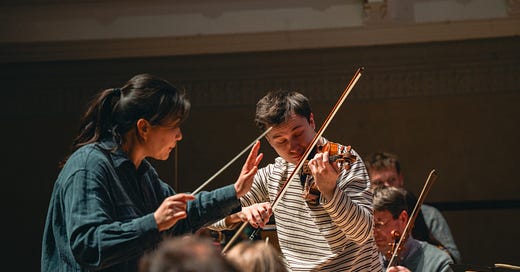Compositions Camouflage in Precious Artefacts: Shiyeon Sung and the Royal Philharmonic Orchestra at Cadogan Hall
Together with violinist Johan Dalene the conductor escorted Sibelius, Tchaikovsky and Nielsen through a stirring but sleepy museum.
Above: Johan Dalene and Shiyeon Sung in rehearsal before Thursday’s concert. Credit: Timothy Lutton/RPO.
Scintillating over plinths, spared souvenirs of history enlist our awe – inspiring gasps and photographs. Scant relics far removed from current hearts, they’re amphoras embraced by phones; crass earbuds near a dodo bone.
Alone and contextless they spark no more than momentary fascination.
Revelations resurrect lost papers crumpled, rolled and dusted through performance: novel pages for a composition’s palimpsest.
Zestfully infilling the Royal Philharmonic Orchestra’s dynamics with brisk forte, conductor Shiyeon Sung sent the ensemble on a spree of escapades at last night’s Cadogan Hall concert. Sibelius’s ‘Night Ride and Sunrise’ opened with precisely tempered strings that struck anticipating beats – inviting other sections to create their fusions of adventure and anxiety. And yet the trill on bass drum seemed a little quiet, percussion instruments trailed woodwind and the latter’s triplets surfaced indistinct. Pizzicato on the lower strings was lacking in expected whimsy and the oboe figure lagged in tempo, leading its fast imitating flute astray.
Alighting at Tchaikovsky’s Violin Concerto with refined – and arguably Classical-resembling – string acciaccaturas, Sung sustained orchestral unity with pageantry becoming to the piece. Soloist Johan Dalene expressed creative pliancy by gradually attacking with a thin vibrato; lengthening the bow’s descent to stretch a note’s potential. Demisemiquaver runs sent virtuosic quivers winding in and out of brusque staccato, hushed diminuendi and a panoply of triplets. A canvas for a vast display of indisputable technique became Dalene’s instrument.
Surrendering to slick septuplets, the experimental player ventured in and out of slim vibrato – often leaving naked notes to sound in unadjusted glory. Portamenti met intriguing pitch bends in the section to be played an octave higher, coming out as trinkets crystalline.
Instilling pristine touches in his climbing chords, Dalene switched from operatic dirges to vibrato-missing tones akin to timbres common in Prokofiev’s repertoire. Disconsolate motifs fit into several bars before transforming into molto mosso (‘very animated’) staves.
Dalene’s stark baring of the instrument bent genres when it came to second movement ‘Canzonetta.’ This long romance was treated with the tempi and dynamics of postmodern music. While its central theme demurred in taciturn withdrawal, the middle notes of its surroundings were remarkably rolled out; extended almost beyond recognition. Such an approach was fascinating to the melomanic ear but also banished the work’s lovelorn lilts.
Double stops popped festively at Dalene’s helm at the start of ‘Allegro vivacissimo.’ Replete with stormy runs and fierce attacks, the violinist’s rendering made birdsong out of screechy pitches. A long diminuendo at the piece’s end emerged alluringly. Cementing his exceptional aesthetics, Johan Dalene accomplished a uniquely styled performance somewhat short on sentiment.
Sung’s orchestra deployed a set of regimented rhythms for the opening of the concerto but they lapsed with rumbling horns and a discordant duo of bassoons. The latter failed to gel with clarinets at the beginning of the ‘Canzonetta’; flutes were late to imitate the solo violin. Pizzicato on the upper strings was executed daintily in the last movement but the piccolo-oboe-flute interplay was obscured.
Strings tingled to unseal Carl Nielsen’s Second Symphony dubbed ‘The Four Temperaments.’ Sterling in their unison, they prompted well-timed dialogues between the flutes and oboes but the brass trailed sorrily behind. Romantic glory soared in radiant crescendo on the violins till horns fell out of place.
Serenely swaying in the ‘Allegro comodo e flemmatico’ movement, violins whisked wishful tones to wistful sways. But later chords marked ppp lacked delicateness and staccato; bassoons withheld diminuendo. Ill-combed textures pestered strings in the third ‘Melancholic’ movement, suddenly enmeshing them in disarray. The central figure of the oboe rode too ostentatious a dynamic while its imitator in the English horn suppressed the melody. A potent tremolo in the concluding bars restored tranquillity.
Fierce timpani defined the final movement ‘Allegro sanguineo – Marziale,’ whose staccato and marcato moments sounded with declamatory force. The most triumphant of the symphony’s contrasting foursome, its audacious punctuation suited Sung’s style best.
Aglimmer at the edges, this performance of Romantic greats swept much of their magnetic lustre to the sides – acquainting us with only fragments of these treasurable antiques.




